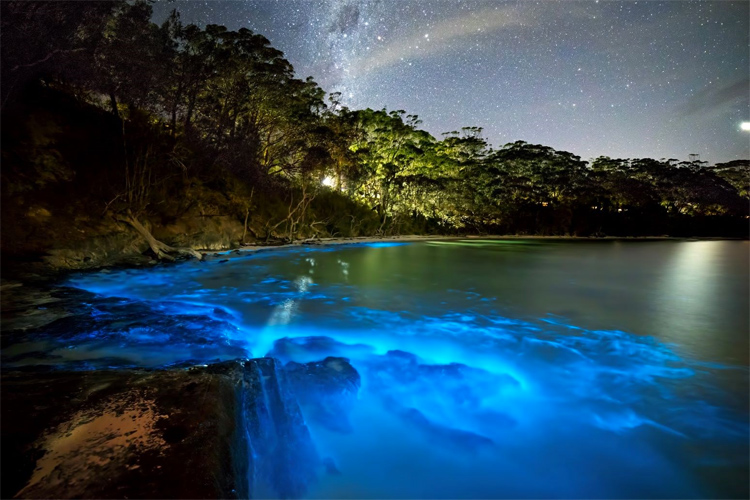Bioluminescence is a chemical process through which marine vertebrates, invertebrates, fungi, and fireflies produce and generate light.
This relatively rare worldwide phenomenon illuminates the ocean, the waves, and the shoreline with a blue glow at night.
The light or glow is created by marine plankton - scientifically known as dinoflagellate - which activates a blue glow when it senses movement in the water.
It could be a fish, a human body, or just the force generated by the breaking of the waves.
During the day, plankton or algae gather energy from the sun. At nightfall, dinoflagellates use it to produce a blue glow.
Since their glow is controlled by circadian rhythms, the light only occurs at night.
It's precisely the same phenomenon that can be observed in fireflies.
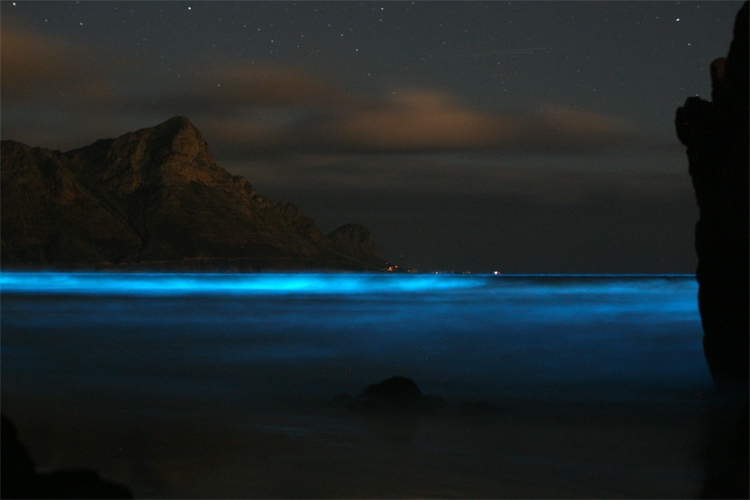
Bioluminescence: A Weapon and a Communication Skill
Surface and deep-sea animals are equipped with multiple accessories and abilities to survive in such a rugged environment.
Scientists believe these ocean creatures use bioluminescence for several different reasons.
They can use it as a flashlight to see or to let other members of the same species find them in the dark.
They might also use it to attract the animals they plan to eat.
When they're attacked, some of them can flash the light like a burglar alarm to get the attention of an even bigger creature like a shark to scare off the attacker.
The glow is believed to be a defensive mechanism that startles predators and makes them vulnerable to creatures of higher trophic levels.
For some species, the light looks just like the faint sunlight coming down from above, and that makes them invisible to predators below.
According to marine biologists, the vast majority of deep-sea animals - from sharks and jellyfish to bacteria and crustaceans - are able to produce light. Probably between 75 and 90 percent.
Marine creatures produce light to communicate with each other, lure or detect prey, and warn or evade predators.
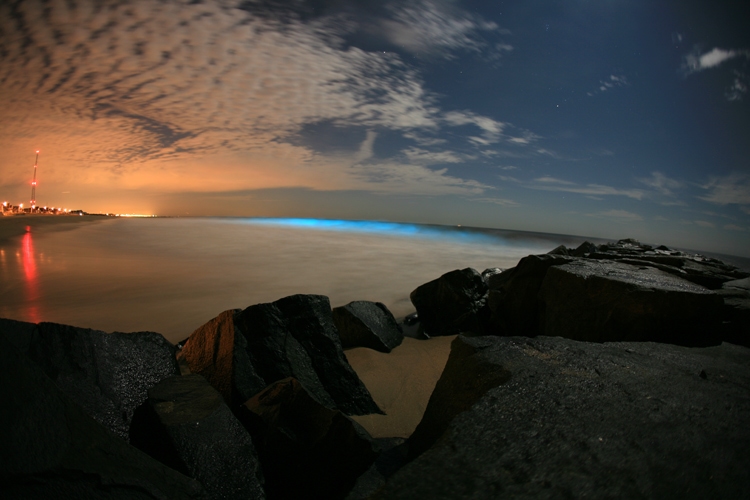
From Red Tides to Bioluminescent Waves
The light emitted by a bioluminescent creature results from the energy released from chemical reactions inside its body.
The majority of animals emit light in the blue and green spectrum, but the genus Tomopteris emits yellow light, and some loose-jawed fish emit red and infrared light.
Dinoflagellates are the most frequently encountered bioluminescent organisms. They are responsible for the bioluminescent waves that can be seen on many beaches at night.
These single-celled creatures are very abundant.
Dinoflagellates are associated with the so-called red tides.
During the day, when this microscopic population increases dramatically, it discolors the water red or brown.
Some of these red tide events are toxic and harmful to humans.
Then, at night, red water turns into magical blue waves.
This sparkling phosphorescent luminosity is a frequent event on the beaches of California, Florida, Australia, Jamaica, Vietnam, Puerto Rico, the United Kingdom, and the Maldives.
Nevertheless, even though it is impossible to predict when they will occur or how long they will last, scientists confirm that they've been going on for a while, at least since 1900.
We know that natural events like changes in water and wind patterns and storms can lead to a drop in bioluminescence levels.
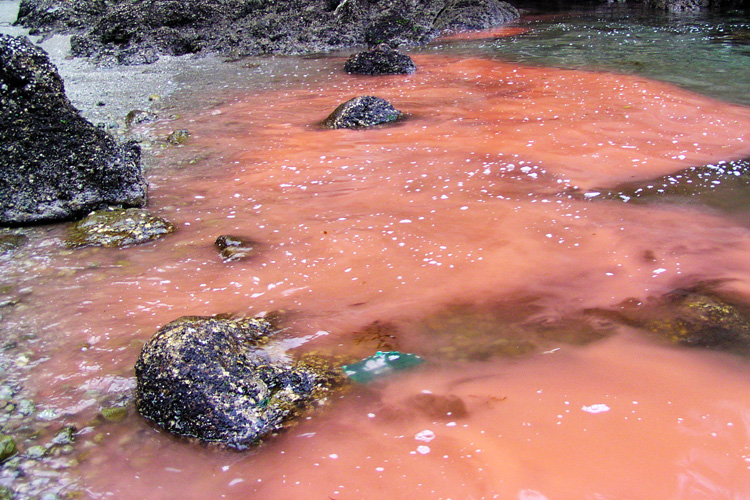
A Mysterious Biochemical Process
It is still unknown why the biochemical process that makes dinoflagellates glow occurs.
However, they believe that particular movements stretch the organism's cell membrane and activate mechanical receptors.
Those receptors then send a signal to scintillons, tiny pods located inside bioluminescent dinoflagellate cells that hold all the compounds needed to produce light.
Apparently, that signal makes each scintillon open ion channels to let in hydrogen ions from an adjoining sack called the acidic vacuole.
As a result, the pH lowers and sets a chemical reaction in motion - an enzyme called luciferase combines oxygen with a compound named luciferin (from the Latin lucifer, or "light-bringer").
And when this reaction occurs, it releases energy in the form of a flash of light.
Although different forms of luciferin can produce different colors, dinoflagellates, and many other bioluminescent marine species emit mainly blue light.
That is probably because blue light can travel farthest in water since water absorbs the other colors in the spectrum more quickly.
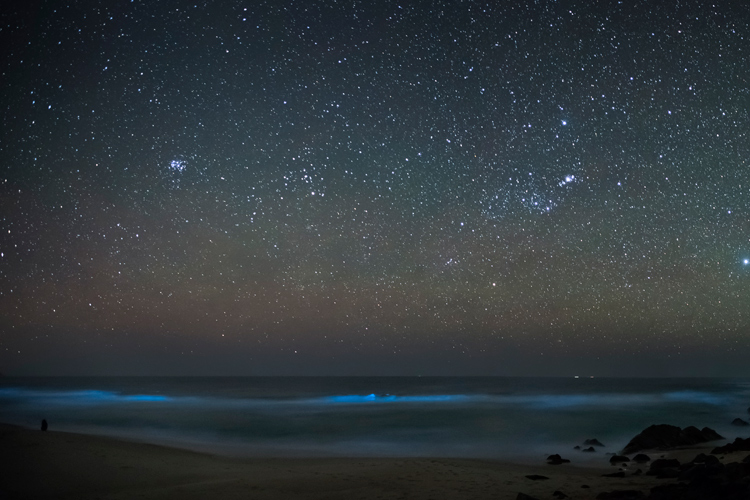
How to Grow Bioluminescent Algae at Home
Believe it or not, you can buy and grow your own bioluminescence algae online and experience it in the comfort of your own home.
You'll need the following materials:
- Shallow, clear growing pot or container;
- Erlenmeyer flask;
- Pipette;
- Sea salt;
- Grow light with a timer;
- Micro Algae Grow;
- Starter culture;
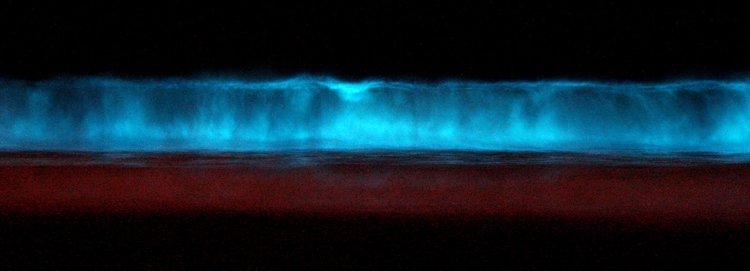
Now, it's time to prepare the bioluminescent formula:
- Carefully clean the container;
- Add sea salt to purified water;
- Mix the sea salt to a 1.019 specific gravity (sg) concentration using a hydrometer;
- Add 1 ml of Micro Algae Grow to the solution;
- Let both the solution and the culture bag rest away from the sun for between 60 and 120 minutes at a temperature of 70 °F (21 °C) - the water temperature should be at the same temperature;
- Use the pipette to deliver the algae to the Erlenmeyer flask;
- Transfer the culture to a dark area;
- Set the grow light with the timer to 12-hour on and 12-hour off cycles;
- Monitor the culture's conditions and shake it if needed;
- Watch it glow blue and beautiful during its night cycle;
